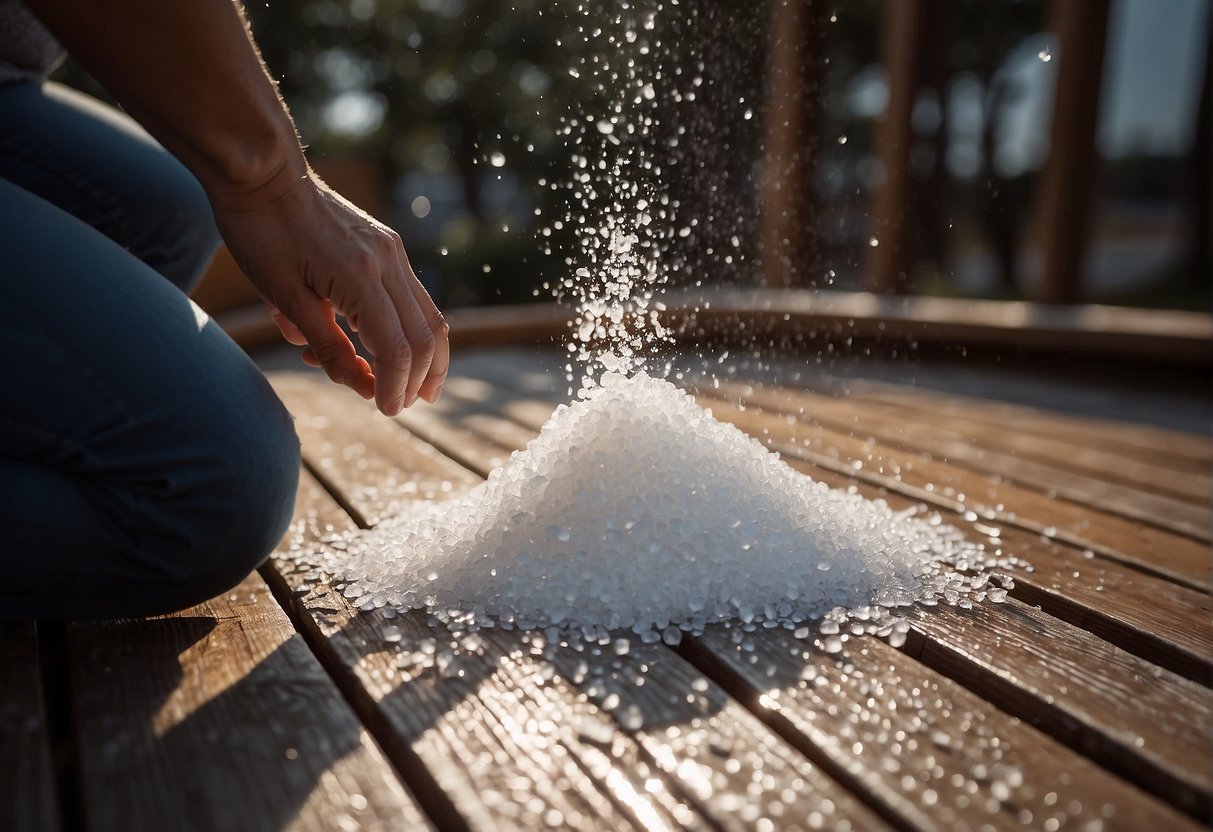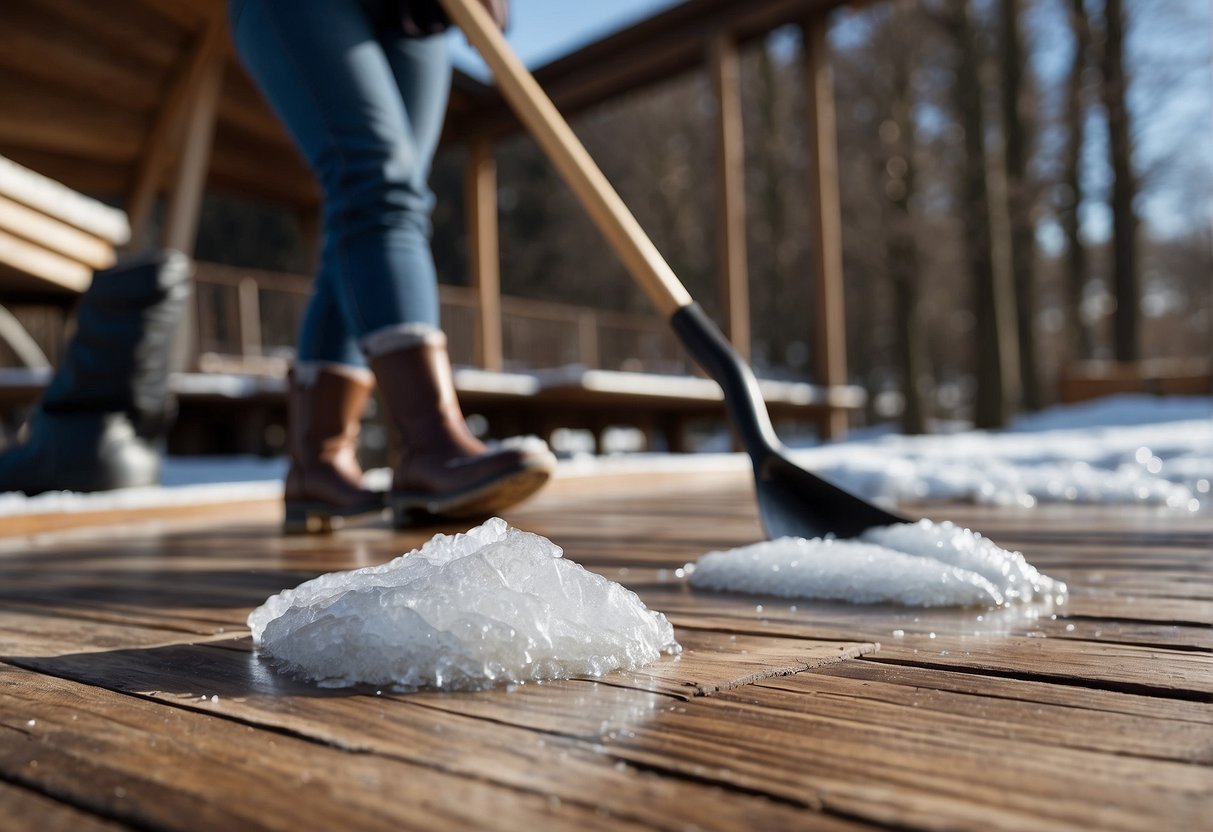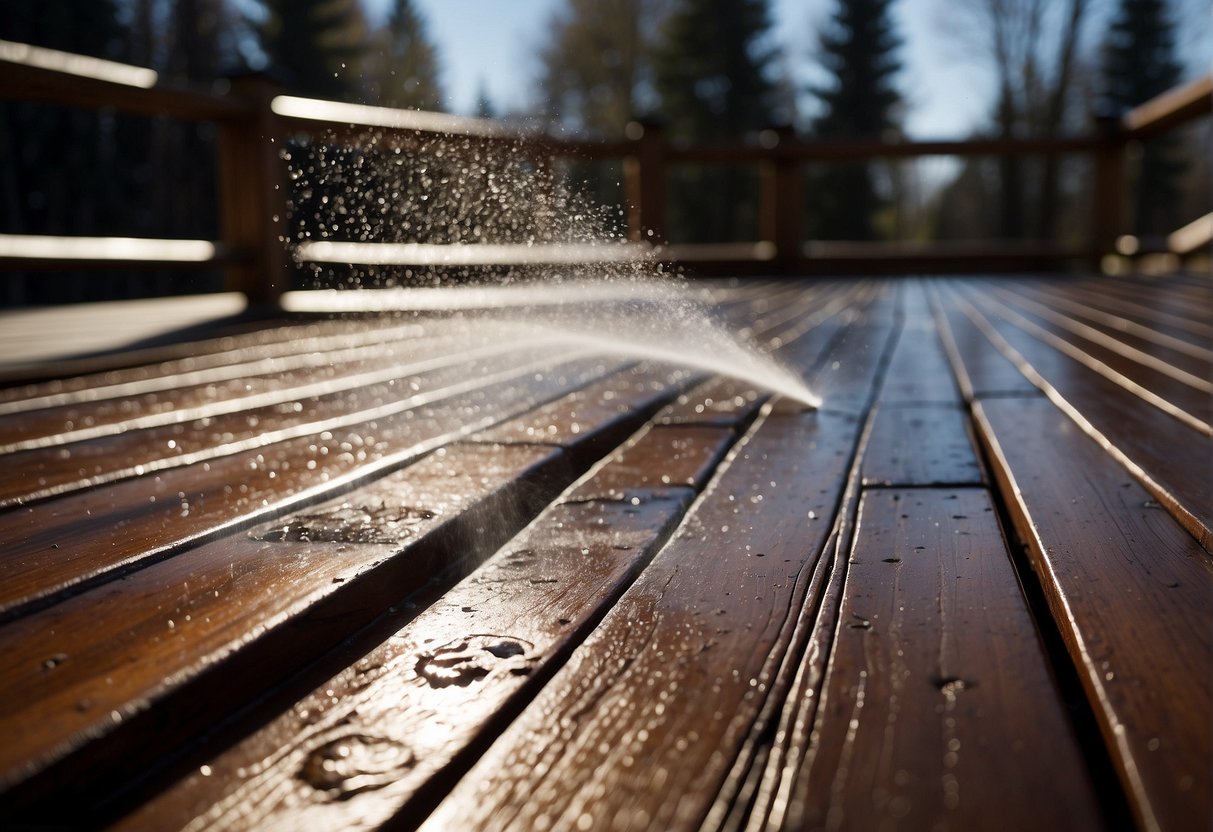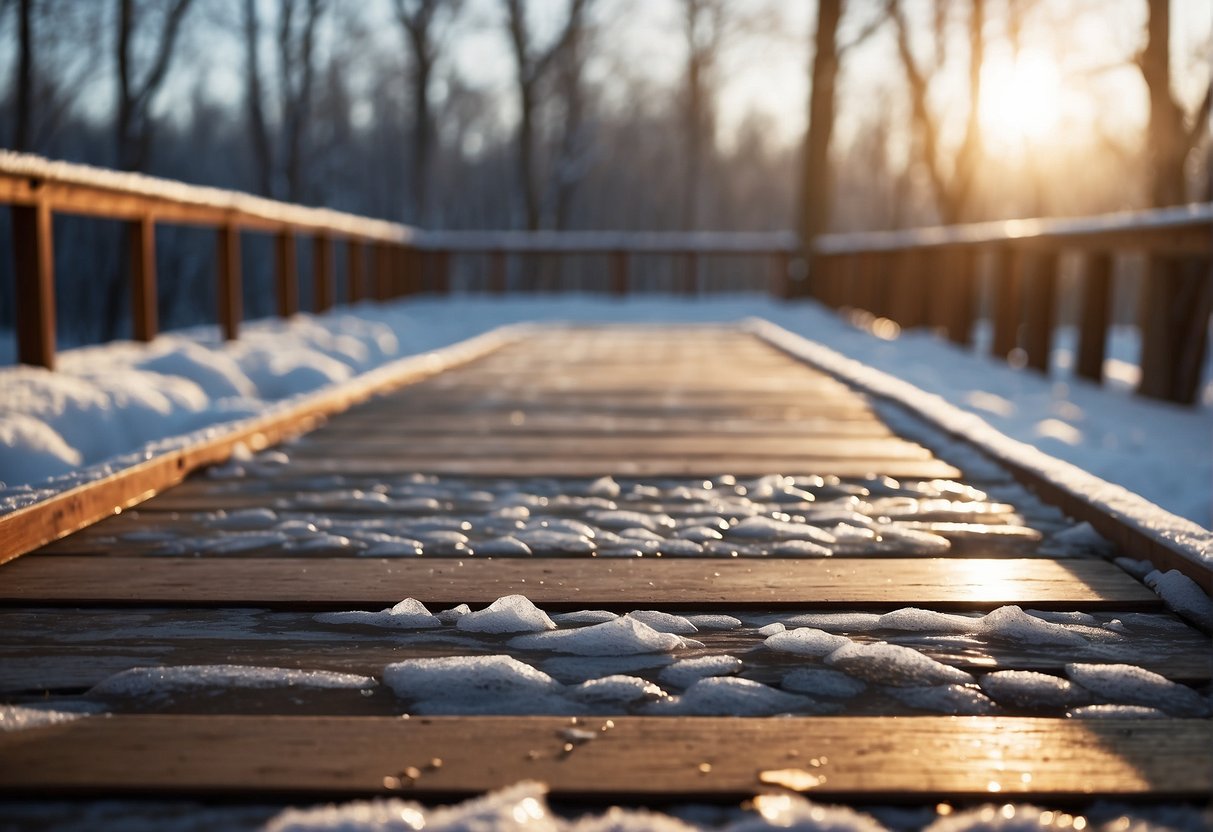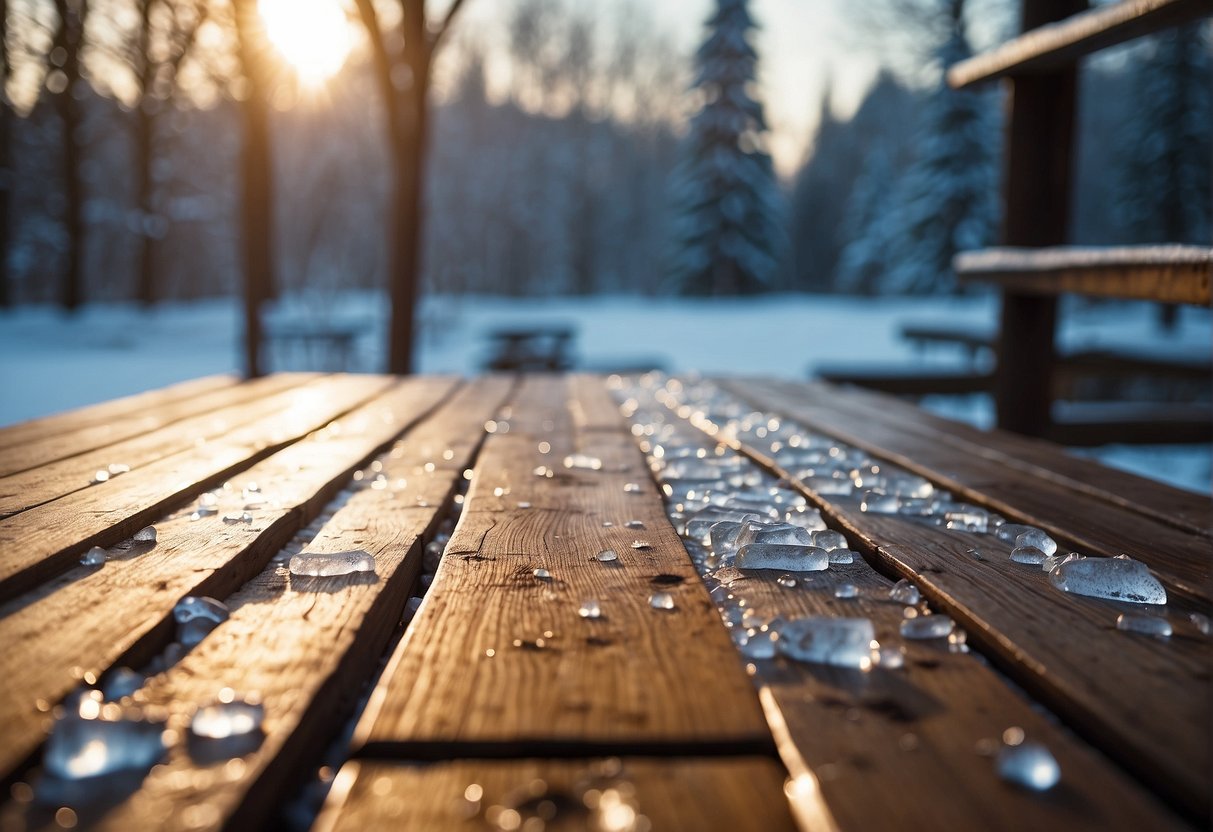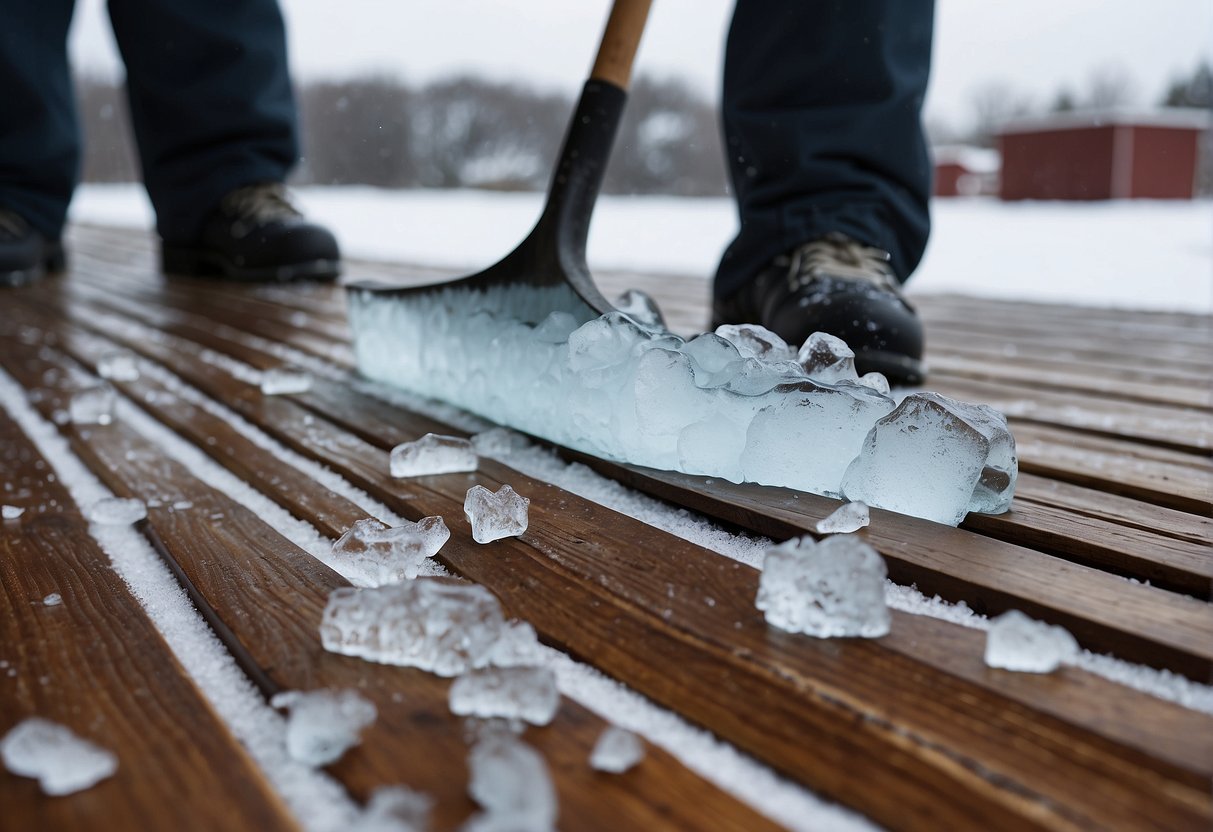Maintaining a wood deck during the winter months can be a challenge as ice formation makes the surface slippery and potentially dangerous. Icy decks pose a risk for slips and falls, which can lead to serious injuries. In cold climates where snow and ice are common, homeowners need to know how to prevent their wood decks from icing over. If left unchecked, a deck covered in ice can also suffer structural damage, leading to expensive repairs.
There are several strategies that can be employed to keep a wood deck ice-free. Regular maintenance and preparation before the onset of winter can significantly reduce the risk of ice accumulation. Applying the right products and employing proper techniques will not only keep the deck safe for use but also prolong its life. By understanding how ice forms and the ways in which it can be safely removed, you can enjoy a winter-safe wooden deck throughout the colder months.
Key Takeaways
- Regular maintenance and seasonal preparation help prevent wood deck icing.
- Appropriate products and techniques are crucial for ice prevention and removal.
- Understanding ice formation is key to maintaining a safe, ice-free deck.
Understanding Deck Icing
When temperatures drop, your wood deck can become a canvas for ice formation. This section focuses on the key factors that lead to icing and the potential hazards if you don’t address the issue promptly.
Causes of Icing
- Temperature Fluctuations: When temperatures hover around the freezing mark, water can repeatedly melt and refreeze, leading to ice buildup.
- Moisture Source: Rain, snow, or even high humidity levels provide ample moisture that will freeze on your deck’s surface in cold weather.
Risks of Ignoring Ice Accumulation
- Physical Harm: If you or someone else slips on ice, it can lead to injuries.
- Deck Damage: Ice can cause wood to split or crack, compromising your deck’s integrity over time.
Preventive Measures
To ensure your wood deck remains free from ice, focus on choosing the right materials for construction and regular deck maintenance.
Material Choices for Construction
- Wood Type: Opt for hardwoods like teak, ipe, or pressure-treated woods that are known for their resistance to weather and decay.
- Sealant: Apply a water-repellent sealant specifically designed for wood decks; this creates a barrier to moisture and ice formation.
Deck Maintenance Tips
- Regular Cleaning: Keep your deck clean from leaves, dirt, and debris. This reduces moisture accumulation, which can lead to icing.
- Drainage: Ensure your deck has proper drainage. Angled boards and adequate spacing between them are crucial for preventing water buildup.
Icing Prevention Techniques
To ensure your wood deck stays safe and ice-free, it’s crucial to apply the right products and techniques before freezing weather sets in.
Safe Ice-Melt Options
When looking for ice-melt products, your focus should be on those that are wood-friendly and pose minimal risk to the surrounding vegetation and pets. Here are a few options:
- Calcium Chloride: This compound works well in temperatures down to -25 degrees Fahrenheit and is less harmful to plants and concrete than other salts.
- Magnesium Chloride: Similar to calcium chloride, magnesium chloride is gentler on the environment and effective in low temperatures.
Product Comparison:
| Product | Lowest Effective Temperature | Pet and Plant Safety |
|---|---|---|
| Calcium Chloride | -25°F | Moderate |
| Magnesium Chloride | -13°F | High |
Applying Anti-Ice Products
Applying anti-ice products before a snowstorm can greatly reduce ice buildup. Here’s how:
- Choose a Liquid Deicer: Liquid deicers can be applied before a storm to prevent ice from bonding to the wood.
- Spread Evenly: Use a garden sprayer or similar tool to ensure an even coat over your deck, which will help maintain an ice-free surface.
remember: Always follow the manufacturer’s instructions for application rates and safety precautions to avoid damaging your deck or harming the surrounding environment.
Ice Removal Strategies
When ice forms on your wood deck, it’s essential to address it promptly to prevent falls and maintain the wood’s integrity. Below are effective strategies for ice removal.
Manual Ice Removal Methods
- Use a Plastic Shovel: Start by gently but firmly s****hoveling** away the ice with a plastic shovel. Avoid using metal shovels as they can scratch or damage the wood.
- Apply Pet-safe Ice Melt: If shoveling alone isn’t effective, consider applying a pet-safe ice melt product. These products should specifically state that they are safe for use on wooden surfaces.
Product Application Rate Notes Pet-safe Ice Melt Follow label instructions Will not harm deck or pets
Heating Solutions for Melting Ice
- Heat Mats: Invest in outdoor heat mats designed for decks. Place these mats strategically to melt the ice. Ensure they are suitable for wooden surfaces to avoid any potential damage.
Placement Duration Effectiveness High traffic areas As needed Excellent for preventing ice buildup - Infrared Heaters: Infrared heaters can be mounted to provide directed warmth to melt ice without the need for direct contact with the wood’s surface.
Distance from Deck Heat Setting Coverage Area Check manufacturer’s manual Medium to High Varies by model
Using these strategies will help maintain your deck’s longevity and keep it free from ice during cold spells.
Frequently Asked Questions
Protecting your wood deck from ice involves using safe products and practices that will not damage the decking material while ensuring safety and preventing slips. Here, you’ll find specific queries addressed with targeted solutions for maintaining your deck during the icy months.
What are some pet-safe ice melt products for wooden decks?
For a pet-friendly approach, look for ice melts labeled as safe for animals, often containing urea or glycol-based ingredients. These products minimize the risk of irritation to your pet’s paws and are less corrosive to wooden decks.
Are there any effective homemade solutions to prevent ice on wood decks?
Yes, mixing half a gallon of warm water with a teaspoon of dish soap and a tablespoon of rubbing alcohol can create an effective solution to prevent ice from forming on your wooden deck. Apply it gently to your deck’s surface.
Can magnesium chloride be safely used on wooden decking material?
Magnesium chloride is less corrosive than sodium chloride and can be safely used on wooden decks. Ensure it’s applied according to the manufacturer’s instructions to prevent damage to the wood.
What is the best way to prevent ice formation on wooden steps?
For wooden steps, apply sand, coffee grounds, or kitty litter to increase traction and minimize ice formation. These options are safe for wood and provide immediate grip.
How can I maintain my wood deck during winter to avoid ice build-up?
Regularly remove snow using a plastic shovel to prevent snow compaction and the subsequent formation of ice. Additionally, ensure proper deck sealing before the onset of winter to protect the wood from moisture and icing.
What are the recommended practices for applying ice melt to a wood deck?
When using ice melt on your wood deck, apply it sparingly and avoid products with colorants that may stain the wood. After the ice has melted, promptly rinse off the residue with water to prevent the chemicals from sitting on the deck for too long.

